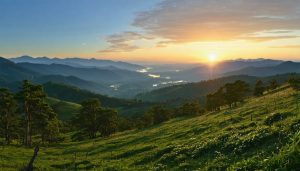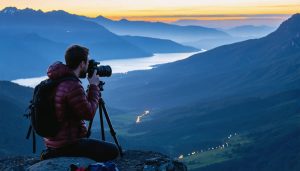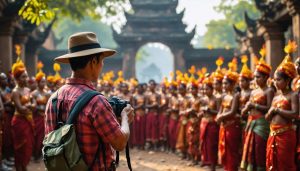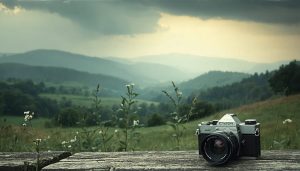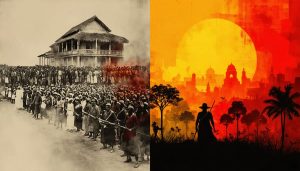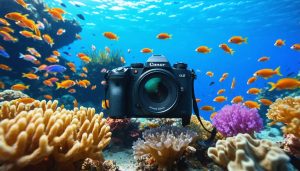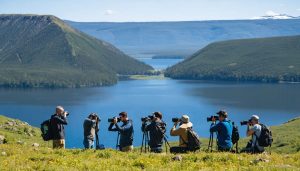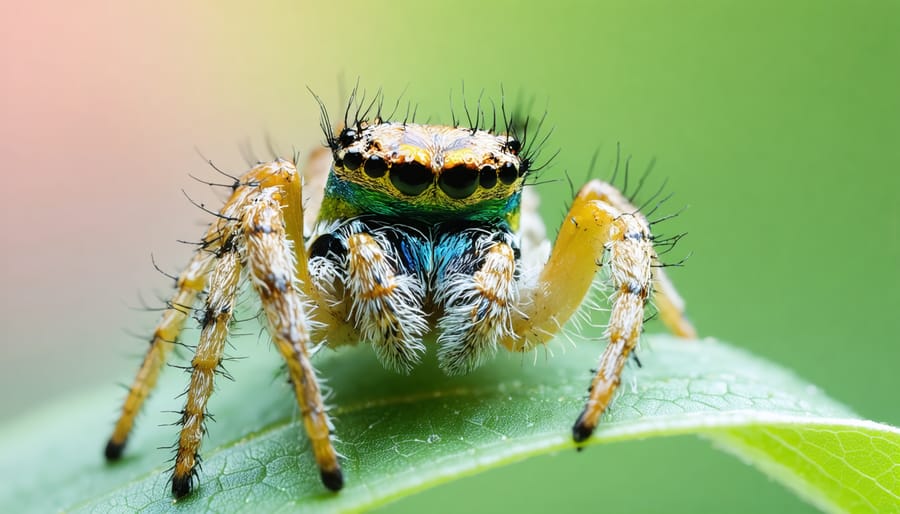
Perched on a leaf with their iridescent eyes and intricate patterns, jumping spiders represent the ultimate challenge in macro photography techniques. These eight-legged acrobats demand a unique combination of patience, precision, and technical mastery to capture their fascinating behavior and stunning details. Unlike static subjects, jumping spiders require photographers to anticipate their quick movements while maintaining critical focus on their primary eyes—often just millimeters in size. Their curious nature and interactive behavior offer unprecedented opportunities for dramatic close-up portraits, but only if you can master the delicate balance of light, speed, and distance. Whether you’re wielding a dedicated macro lens or experimenting with extension tubes, these diminutive hunters will push your skills to their limits while rewarding you with some of the most compelling macro images possible.
Essential Macro Photography Equipment for Jumping Spiders
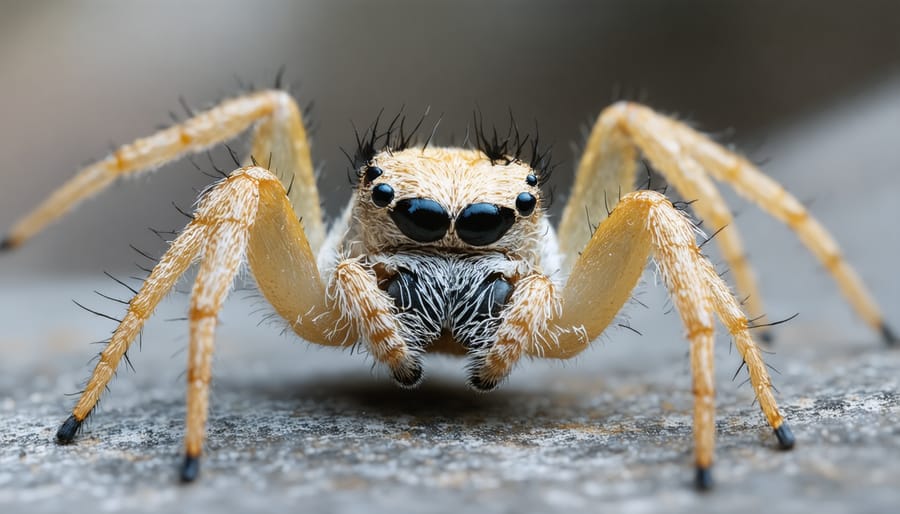
Choosing the Right Macro Lens
When photographing jumping spiders, your choice of macro lens can make or break the shot. For these small arachnids, a lens with a magnification ratio of 1:1 is essential, allowing you to capture life-size images of your subject. Most photographers find success with focal lengths between 90mm and 105mm, which provide an ideal working distance of about 6-12 inches from the spider.
While shorter focal lengths like 60mm can work, they require you to get uncomfortably close to the spider, often causing it to flee. Longer focal lengths such as 150mm or 180mm offer excellent working distance but tend to be heavier and more expensive. They’re worth considering if you plan to photograph particularly skittish specimens.
Consider investing in a lens with built-in image stabilization, as this feature proves invaluable when shooting handheld. Modern macro lenses with fast and quiet autofocus systems can also be beneficial, though many photographers prefer manual focusing for precise control. Whatever lens you choose, ensure it offers weather sealing if you plan to shoot outdoors frequently, as jumping spiders often inhabit damp environments.
Lighting Setup and Flash Options
Proper lighting is crucial when photographing jumping spiders, as their metallic colors and intricate details require careful illumination. Understanding macro lighting techniques is essential for capturing these fascinating arachnids in their best light.
A dual flash setup often yields the best results, with one flash serving as the main light and another as fill. Position your main flash at a 45-degree angle to illuminate the spider’s eyes and front features, while the fill light helps reduce harsh shadows. For beginners, a ring flash can provide even illumination, though it may create flat-looking images.
Natural light can work wonderfully for jumping spider photography, especially during the golden hours. However, you’ll need to diffuse harsh sunlight using a translucent reflector or small diffusion panel. Many photographers find success using a combination of natural light and flash, with the flash acting as a subtle fill to bring out detail in shadowed areas.
Consider using small LED panels for continuous lighting when composing your shot. While they may not provide enough power for the final exposure, they’re excellent for helping you focus and position your camera without disturbing the spider. DIY solutions like white paper or foam board reflectors can effectively bounce light into shadowed areas.
Remember that jumping spiders have reflective eyes that can create unwanted hotspots. Using multiple small diffusers on your flashes helps create soft, wrapping light that reveals detail without harsh reflections. Experiment with different diffusion materials, from commercial solutions to DIY options like tissue paper or white plastic.
Camera Settings for Spider Macro Photography
Mastering Manual Focus
When photographing jumping spiders, achieving precise manual focus is crucial for capturing their intricate details. While autofocus can be helpful, mastering close-up photography often requires a more hands-on approach.
Start by switching your lens to manual focus and position yourself at your lens’s minimum focusing distance. Rather than turning the focus ring, gently rock your body forward and backward until the spider’s eyes come into sharp focus. This technique offers more precise control than trying to adjust the focus ring for such minute movements.
For optimal results, focus specifically on the anterior median eyes (the largest forward-facing eyes). These are the jumping spider’s primary eyes and should be the sharpest part of your image. If possible, position yourself so that both sets of front-facing eyes are on the same focal plane.
Consider using focus peaking if your camera offers this feature. This tool highlights areas of sharp focus in your viewfinder or on your LCD screen, making it easier to confirm precise focus on your tiny subject. If your camera has focus magnification, use it to zoom in on the spider’s eyes while composing your shot.
Remember that at such high magnifications, even the slightest movement can throw off your focus, so stability is paramount. Take multiple shots whenever possible to ensure at least one image achieves perfect focus.
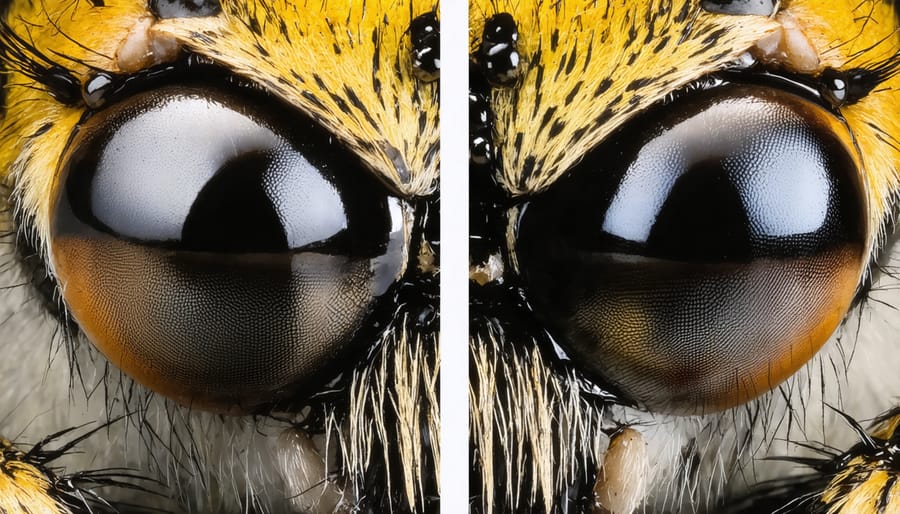
Exposure Settings for Clear Details
Capturing jumping spiders in crisp detail requires careful attention to your optimal camera settings. For these tiny subjects, start with an aperture between f/8 and f/16 to achieve sufficient depth of field while maintaining image sharpness. Remember that jumping spiders are typically just a few millimeters in size, so every fraction of depth matters.
Your shutter speed needs to be fast enough to freeze both camera shake and the spider’s movements. Since these creatures can jump up to 50 times their body length in an instant, aim for at least 1/200th of a second or faster. When using flash, you can often go up to 1/250th, which is typically the flash sync speed for most cameras.
ISO settings require a delicate balance. While a lower ISO (100-400) provides the cleanest images with minimal noise, you may need to push it higher when working in challenging light conditions. Modern cameras can handle ISO 800-1600 quite well, but try to avoid going higher to maintain image quality.
When using flash, which is often necessary for macro spider photography, set your flash power between 1/16 to 1/4 depending on your distance to the subject. This provides enough light while avoiding harsh highlights that can wash out the spider’s delicate features and iridescent colors.
Consider using manual mode for complete control, but aperture priority can work well too, especially when dealing with changing light conditions. The key is maintaining consistent exposure across your shooting session while ensuring the spider’s features remain sharp and well-defined.
Field Techniques and Approach Methods
Finding and Identifying Jumping Spiders
Jumping spiders are most active during daylight hours, making them perfect subjects for daytime macro photography. Look for these charismatic arachnids on sunny walls, garden foliage, and fence posts, particularly during mid-morning when they’re actively hunting. Their distinctive eye arrangement and jerky movements make them easily identifiable among other spiders.
The best seasons for jumping spider photography are spring and summer when they’re most abundant. During these months, scan leaf surfaces and flowers where they hunt for prey. Many species can be found at eye level or below, making them relatively accessible subjects. Garden areas with diverse plant life tend to attract more specimens.
For consistent success, develop a routine of checking the same locations daily, as jumping spiders often establish regular hunting territories. Pay special attention to areas with morning sun exposure, as these spots typically attract more active individuals. Look for their silk retreat lines, which they use as safety tethers while hunting – these can lead you to their preferred haunts.
Weather conditions significantly impact jumping spider behavior. Calm, sunny days are ideal for photography as the spiders are more active and less likely to retreat. Avoid shooting in windy conditions, as this makes both finding and photographing the subjects considerably more challenging.
Pro tip: Wear bright clothing when searching, as jumping spiders are visually oriented and will often notice you before you notice them, potentially leading to interesting behavioral shots.
Getting Close Without Scaring Them Away
Approaching jumping spiders requires a delicate balance of patience and technique. These fascinating creatures are naturally curious but easily startled, so your movements must be slow and deliberate. Start by maintaining a reasonable distance of about 12-18 inches and gradually move closer in small increments.
One effective technique is to approach from a slight angle rather than head-on, as this appears less threatening to the spider. Watch their behavior closely – if they start to raise their front legs or turn to face you directly, pause your approach and give them time to acclimate to your presence.
Using a longer working distance macro lens (around 100mm) allows you to maintain a comfortable gap while still achieving detailed shots. If you’re working with shorter focal lengths, consider using extension tubes to increase your working distance.
Movement management is crucial. Support your camera with both hands and, if possible, brace your elbows against your body for stability. When the spider shows interest in your presence – often turning to look at you with those characteristic large eyes – this is your opportunity to capture compelling shots.
Remember that lighting equipment can startle them, so introduce any flash or LED panels gradually. Many photographers find success by setting up their lighting first and then waiting for the spider to return to its preferred spot.
Working with Natural Behavior
Understanding jumping spider behavior is crucial for capturing compelling macro photographs. These small arachnids are naturally curious and have excellent vision, which you can use to your advantage. Unlike other spiders, they actively hunt during daylight hours and will often turn to face you, providing perfect opportunities for striking eye-level shots.
To work with their natural behavior, approach slowly and avoid casting shadows over them. Jumping spiders are typically most active during mid-morning when they’re hunting, making this an ideal time for photography. They frequently pause to observe their surroundings, giving you precious seconds to compose your shot.
When a jumping spider raises its front legs or turns sideways, it’s likely feeling threatened and may leap away. Back off slightly and remain still; they usually resume normal behavior within minutes. Look for spiders on vertical surfaces like walls or tree bark, as they prefer these hunting grounds and will often display interesting behaviors there.
Temperature affects their activity levels – they’re most animated on warm, sunny days between 70-85°F (21-29°C). During cooler weather, they move more slowly, potentially allowing for easier shots but less dynamic poses. Watch for courtship displays between males and females, which offer spectacular photographic opportunities with dramatic poses and movements.
Remember that patience is key. Spend time observing their patterns before raising your camera, and you’ll be rewarded with more natural, engaging images that capture their distinctive personality.
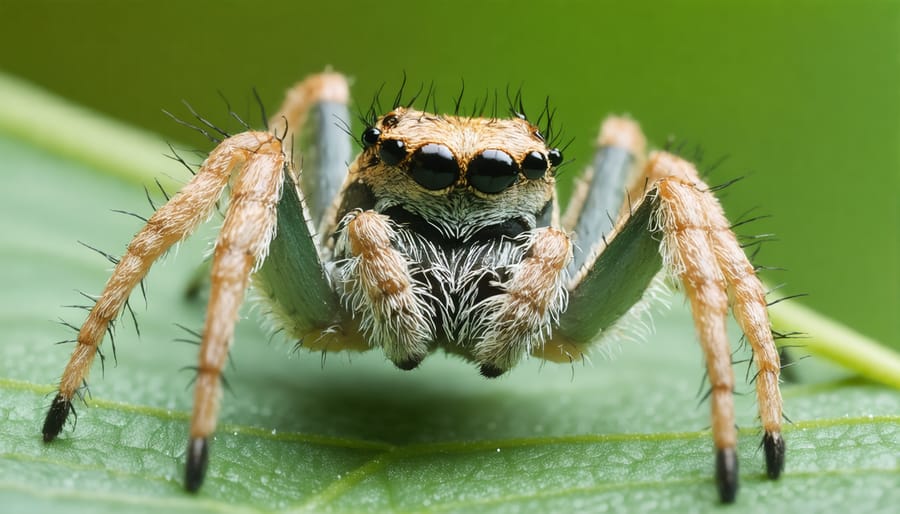
Post-Processing Tips for Spider Macro Photos
Focus Stacking Basics
When photographing jumping spiders at high magnifications, achieving front-to-back sharpness in a single shot is nearly impossible due to the extremely shallow depth of field. This is where focus stacking techniques become essential for creating stunning macro images.
The process involves taking multiple photographs of your spider subject, adjusting the focus point slightly between each shot. Typically, you’ll need anywhere from 10 to 30 images, depending on the magnification and the depth of your subject. Start by focusing on the nearest point of the spider (usually the front eyes) and gradually move your focus toward the back of the subject, ensuring each shot overlaps with the previous one by about 30%.
For the best results, use a macro focusing rail to make precise adjustments. These mechanical devices allow you to move your camera forward or backward in tiny increments, maintaining consistent spacing between focus points. Keep your camera settings identical across all shots, and ensure your spider subject remains perfectly still throughout the process.
Once you’ve captured your series of images, specialized software like Zerene Stacker or Helicon Focus can automatically align and blend the sharpest parts of each photo into a single, crystal-clear image. The software analyzes each pixel, selecting the areas of maximum sharpness from each frame to create a final photograph with edge-to-edge clarity that would be impossible to achieve in a single exposure.
Remember that patience is key – jumping spiders can be active subjects, so you might need several attempts to capture a complete stack of sharp images.
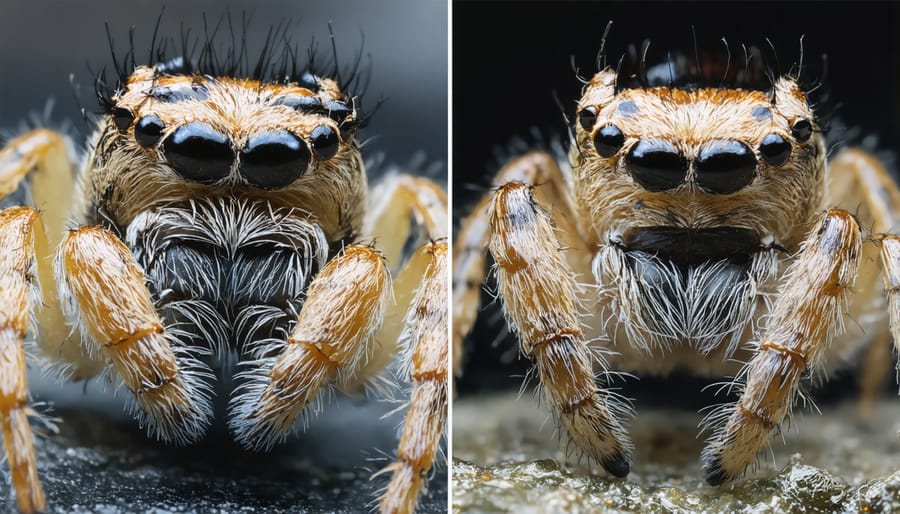
Color and Detail Enhancement
When it comes to jumping spider photography, post-processing can truly bring out the incredible details and colors these charismatic arachnids possess. Start by making subtle adjustments to contrast and clarity to emphasize the spider’s distinctive eye arrangement and intricate body patterns. Be careful not to over-sharpen, as this can create unnatural-looking artifacts around the fine hairs and leg segments.
Color enhancement should be approached with restraint – while jumping spiders naturally display beautiful iridescent colors, especially in their chelicerae and eyes, avoid oversaturating these elements. Instead, focus on bringing out their natural vibrancy through selective color adjustments. The key is to maintain authenticity while highlighting the spider’s natural beauty.
Pay special attention to the background tones. Often, slightly darkening or desaturating the background can help the spider stand out without looking artificial. This technique is particularly effective when working with photos taken in natural settings where busy backgrounds might compete for attention.
Focus stacking software can be invaluable for bringing out details throughout the spider’s body. Since macro photos typically have a very shallow depth of field, combining multiple images taken at different focus points helps achieve tack-sharp results from the frontmost eyes to the rear abdomen.
For the final touches, consider subtle vignetting to direct attention to your subject, and use dodging and burning techniques to enhance the dimensionality of the spider’s form. Remember that the goal is to showcase these fascinating creatures as they appear in nature, just with their best features emphasized through thoughtful post-processing.
Capturing the intricate details and fascinating behavior of jumping spiders through macro photography is both challenging and immensely rewarding. As we’ve explored throughout this guide, success in this specialized field requires a combination of proper equipment, technical knowledge, and field craft skills.
Remember that patience is your greatest ally when photographing these charismatic arachnids. Their curious nature and intelligent behavior make them ideal subjects, but mastering the techniques we’ve discussed takes practice and persistence. Start with basic equipment and gradually build your kit as your skills develop. Even a simple macro lens or extension tubes can yield impressive results when combined with proper technique.
The key takeaways for successful jumping spider macro photography include maintaining a safe working distance, using appropriate flash diffusion, and mastering manual focus techniques. Don’t forget the importance of understanding spider behavior – knowing when and where to find these creatures, and how to approach them without causing stress, will dramatically improve your success rate.
Post-processing plays a vital role in bringing out the best in your images, but remember that good technique in the field will always yield better results than trying to fix problems later. Focus stacking, while sometimes challenging to execute, can elevate your images to new levels of detail and clarity.
We encourage you to start practicing these techniques in your own backyard or local park. Jumping spiders are widespread and can be found in various environments. Begin with easier shots of stationary spiders before attempting more challenging action shots or behavioral sequences. Join online communities dedicated to macro photography to share your work and learn from others’ experiences.
Most importantly, approach this subject with respect for these fascinating creatures and their environment. The joy of macro photography comes not just from the images we create, but from the intimate glimpses into the miniature world these remarkable spiders inhabit. With practice and dedication, you’ll soon be capturing stunning images that showcase the extraordinary beauty of jumping spiders.


